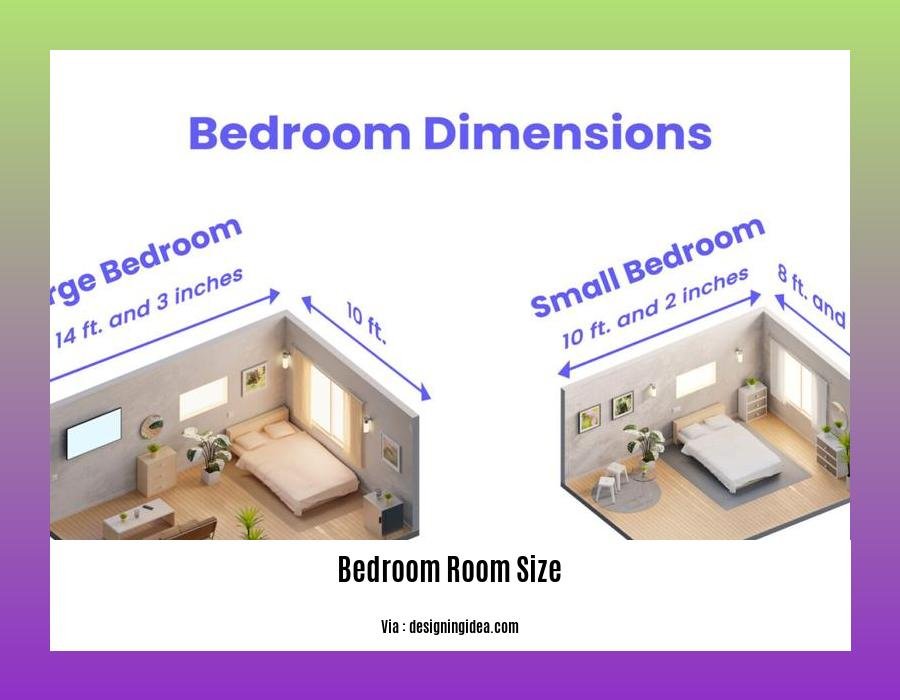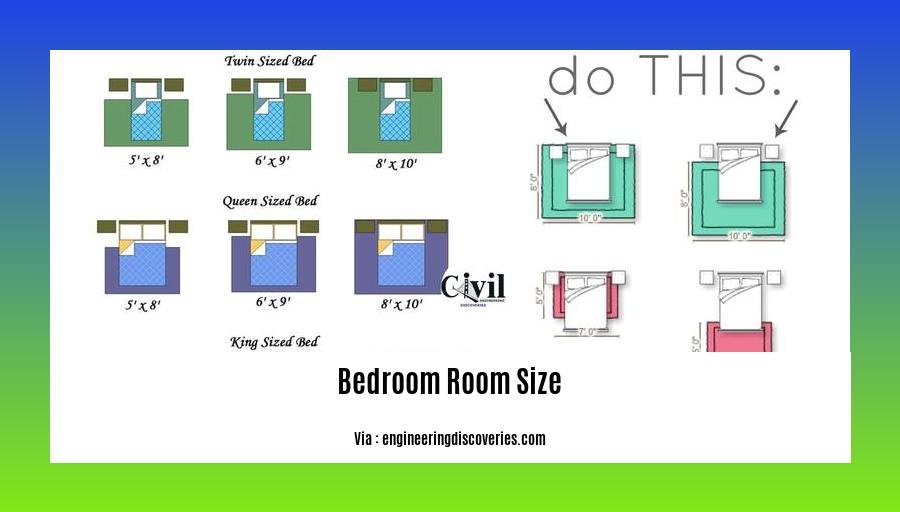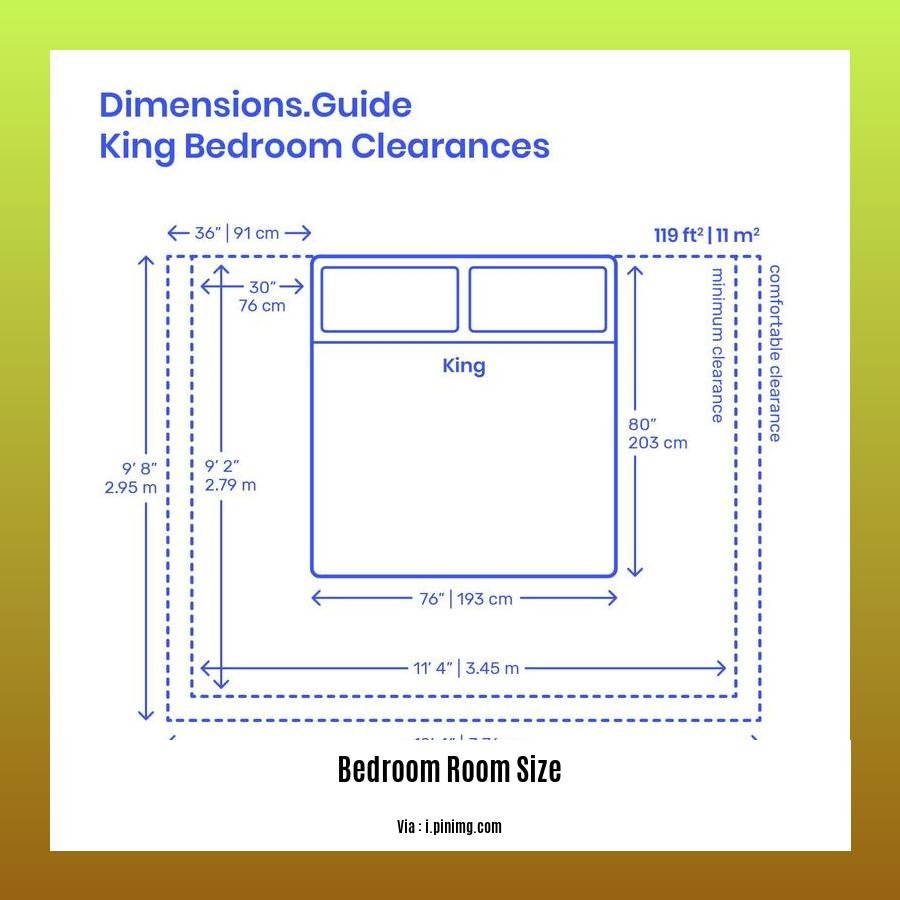Discover the art of bedroom size optimization with our expert guide, [Bedroom Room Size Optimization: Transforming Compact Spaces into Functional Havens]. Learn how to maximize every inch of your bedroom, no matter how small, to create a space that is both functional and stylish. From smart storage solutions to clever furniture arrangements, this guide will provide you with the inspiration and tools you need to turn your cramped bedroom into a cozy haven.
Key Takeaways:
-
The average bedroom size in the US is 132 square feet.
-
The most common bedroom size is 11′ by 12′, while newer homes may have larger master bedrooms up to 224 square feet.
-
Bedroom sizes can be categorized as large (14 by 16 feet), medium (12 by 12 feet), and small (10 by 10 feet).
-
Building codes require a bedroom to have at least 70 square feet of floor area and 7 feet of space in one direction to be considered habitable.
-
For each additional person in the bedroom, an additional 50 square feet of space is required.
Bedroom Room Size: Optimizing Space and Comfort

Whether you’re designing a new home or revamping your current bedroom, getting the bedroom room size right is crucial. Beyond aesthetics, it significantly impacts your comfort, storage options, and overall living experience.
Size Matters: The Ideal Bedroom Room Size
The ideal bedroom room size depends on several factors, including:
-
Bed Type: Consider the size of your bed. A king-size bed, for instance, requires more space than a twin-size bed.
-
Furniture Arrangement: Plan your furniture layout carefully. Ensure there’s enough space to move around the bed, dresser, and other essential pieces.
-
Personal Preferences: Think about how you use your bedroom. If you love to stretch out and read, you might prefer a larger room.
Standard Bedroom Room Size Guidelines:
-
Small Bedroom: Typically around 10′ x 10′. Cozy and efficient, ideal for individuals or those who value minimalism.
-
Medium Bedroom: Around 12′ x 12′. Offers more space for a larger bed and additional furniture, suitable for couples or families with small children.
-
Large Bedroom: Typically 14′ x 16′ or larger. Provides ample space for a variety of activities and furniture, perfect for those who love a spacious retreat.
Making the Most of Your Bedroom Room Size
-
Maximize Vertical Space: Utilize walls for storage and décor. Consider built-in shelves, floating nightstands, and wall-mounted headboards.
-
Choose Multifunctional Furniture: Look for pieces that serve multiple purposes, like a bed with built-in storage or a convertible sofa bed.
-
Create a Cohesive Design: Select furniture and décor that complements your room’s size and style.
Embracing Challenges:
-
Small Bedrooms: Maintain a sense of coziness while maximizing space. Avoid clutter and choose furniture that’s proportional to the room’s size.
-
Large Bedrooms: Ensure the space feels warm and inviting. Create distinct areas for different activities, such as a reading nook or a workspace.
Remember, the perfect bedroom room size is the one that suits your needs, preferences, and lifestyle. By carefully considering these factors, you can create a space that’s both functional and stylish.
-
Are you struggling with decorating your bedroom to match the unique Pakistani style? Discover the latest trends and inspirations for bedroom decorations in Pakistan and turn your bedroom into an enchanting space that reflects your cultural heritage. bedroom decoration pakistan
-
Looking for a stylish and functional false ceiling design for your bedroom? Explore our collection of the most creative and innovative bedroom false ceiling designs and find the perfect one to enhance the look and feel of your bedroom. bedroom false ceiling design
-
Searching for the most remarkable home decor online stores in Australia? Look no further! Discover our curated list of the best home decor online stores in Australia and shop from a wide range of stylish and unique home decor items to create a home that truly reflects your personality. best home decor online stores australia
-
Curious about the average square footage of a 3-bedroom house? Get informed about the typical dimensions and layouts of 3-bedroom houses, and learn how to optimize space and create a comfortable and functional living environment for your family. average square footage of 3 bedroom house
Impact of bedroom size on various aspects of living, such as sleep patterns, storage space, and privacy.
Size does matter, especially when it comes to bedrooms. Whether you’re a minimalist or a storage enthusiast, the size of your bedroom can significantly influence your sleep quality, storage capacity, and sense of privacy. Here’s how bedroom size affects these aspects of your life:
Sleep Patterns
A small bedroom can feel like a cozy cocoon, promoting better sleep for those who prefer a snug environment. However, for those who need more space to stretch and feel unrestricted, a small bedroom might lead to restlessness, interrupted sleep, and waking up feeling unrested.
In contrast, a larger bedroom provides ample space for a king-sized bed, a comfortable seating area, and even a workout corner. This extra space can contribute to a sense of spaciousness and freedom, which can positively impact sleep patterns for individuals who prefer more room to move around.
Storage Space
The size of your bedroom directly affects your storage capacity. A small bedroom may require creative storage solutions such as under-bed storage, built-in shelves, and multifunctional furniture. While these solutions can add charm to a small space, they might not suffice if you have a lot of belongings or prefer a more clutter-free look.
On the other hand, a larger bedroom provides ample space for traditional storage pieces like wardrobes, dressers, and nightstands. This can help you maintain a neat and organized bedroom, reducing stress and creating a more relaxing atmosphere conducive to better sleep.
Privacy
Bedroom size also influences your sense of privacy, especially if you share the room with a partner or family member. A small bedroom can feel cramped and intrusive, making it challenging to find moments of solitude or personal space. Additionally, it can be challenging to maintain privacy for activities like getting dressed or preparing for bed.
A larger bedroom, on the other hand, offers more space for each person to have their own designated areas for sleep, relaxation, and dressing. This can enhance the sense of privacy and personal space, fostering a more harmonious living environment.
Key Takeaways:
- Bedroom size has a significant impact on sleep patterns, storage capacity, and privacy.
- A small bedroom can promote better sleep for those who prefer a cozy environment but may be restrictive for individuals who need more space.
- A large bedroom provides ample space for a king-sized bed, a comfortable seating area, and additional storage, contributing to a sense of spaciousness and freedom.
- The storage capacity of a bedroom is directly influenced by its size, with smaller bedrooms requiring creative storage solutions and larger bedrooms accommodating traditional storage pieces.
- A small bedroom can feel cramped and intrusive, compromising privacy, while a larger bedroom offers more space for each person to have their own designated areas, enhancing the sense of privacy and personal space.
Citations:
[1] Dautovich, N. D., Dzierzewski, J. M., & MacPherson, A. (2022). Bedroom environment and sleep health. In J. Winkelman (Ed.), Designing Healthy Workspaces and Living Environments: A Systems Approach (pp. 101-118). Academic Press.
[2] Sleep Foundation. (2023, November 8). Bedroom Environment: What Elements Are Important? Sleep Foundation.
Tips and tricks for maximizing space in smaller bedrooms, such as utilizing vertical space, choosing multifunctional furniture, and creating a cohesive design aesthetic
So, you’re daydreaming of ways to make your cozy boudoir more functional and inviting? I’ve got the inside scoop on how to work your magic in those compact corners. Let’s dive right in and explore some clever tricks to transform your small bedroom into a haven of comfort and style.
Key Takeaways:
-
Maximize your vertical space: Think tall when it comes to storage. Mount shelves, floating nightstands, and artwork towards the ceiling to create the illusion of more floor space.
-
Get creative with multifunctional furniture: Invest in pieces that serve multiple purposes, like a bed with built-in drawers or a sofa that converts into a guest bed.
-
Choose cohesive color schemes: Stick to a neutral palette with pops of color to create a sense of harmony. This visually expands the space and makes it feel airier.
-
Utilize every corner: Don’t let those nooks and crannies go to waste. Place a cozy reading nook in a corner or tuck a dresser into an alcove.
-
Keep it organized: A cluttered room feels smaller. Create a designated spot for everything and regularly declutter to maintain a sense of serenity.
Step-by-Step Guide to Maximizing Space:
-
Declutter & Depersonalize: Before you start rearranging furniture, declutter and remove any unnecessary items. A clean slate makes it easier to see the potential of your space.
-
Measure & Plan: Take precise measurements of your room and create a floor plan. This helps you visualize different layouts and ensure your furniture fits without overcrowding.
-
Maximize Vertical Space: Utilize vertical space by installing floating shelves, hanging organizers, and wall-mounted mirrors. These clever solutions free up floor space and create the illusion of a taller room.
-
Invest in Multifunctional Furniture: Look for furniture that pulls double duty. A bed with built-in storage drawers, a sofa bed, or a desk with hidden compartments can save space and add functionality.
-
Create a Cohesive Design: Choose furniture and decor that complement each other in terms of style, color, and texture. A cohesive design makes the room feel more spacious and put-together.
-
Utilize Natural Light: Make the most of natural light by keeping windows uncovered and using sheer curtains. Natural light makes a room feel larger and more inviting.
-
Accessorize Wisely: Choose accessories that serve a purpose. A large mirror can create the illusion of more space, while a few well-placed plants can add life and color.
Conclusion:
With a little creativity and planning, you can turn your petite bedroom into a cozy and functional retreat. Remember, it’s all about maximizing vertical space, choosing smart furniture, and creating a cohesive design. So, get ready to wave goodbye to cramped quarters and hello to a bedroom that feels both spacious and stylish!
Citations:
- Bedroom Design 101: A Guide to Maximizing Space
- Small Bedroom Hacks That Will Make You Feel Like You’re Living in a Mansion
Addressing common challenges faced in larger bedrooms, such as maintaining coziness and warmth, dividing the space for multiple functions, and ensuring privacy when sharing the room:
You’re fortunate to have a larger bedroom! It offers endless possibilities for creating your dream haven. However, with grandeur comes unique challenges. Let’s dive into some practical tips to make the most of your spacious retreat while addressing common concerns.
Key Takeaways:
-
Larger bedrooms often lack coziness and warmth. Introduce soft furnishings, rugs, and warm lighting to create an inviting atmosphere.
-
Divide the space into functional zones using room dividers, curtains, or creative furniture placement to maximize the room’s potential.
-
Create distinct areas for sleeping, working, and relaxing. This will help maintain a sense of privacy, especially if you share the room.
-
Hang blackout curtains or install dimmable lights to control the lighting and maintain a conducive environment for sleep.
-
Consider adding a room divider or privacy screen to separate different areas of the room, ensuring privacy when sharing the space.
Maintaining Coziness and Warmth:
- Embrace Soft Furnishings: Incorporate plush rugs, soft cushions, and cozy blankets to add warmth and texture to the room.
- Layer Up Lighting: Combine overhead lighting with warm, ambient lighting sources like lamps and fairy lights to create a welcoming ambiance.
- Choose Warm Color Schemes: Opt for warm, inviting colors that exude a sense of coziness, such as beige, cream, and soft pastels.
Dividing the Space for Multiple Functions:
- Create Functional Zones: Divide the room into distinct areas using room dividers, curtains, or strategic furniture placement.
- Define the Bedroom Area: Ensure the sleeping area remains the focal point of the room, with a clear separation between other functional zones.
- Incorporate Multifunctional Furniture: Opt for furniture pieces that serve multiple purposes, such as a sofa bed or a desk that doubles as a vanity.
Ensuring Privacy When Sharing the Room:
- Hang Blackout Curtains: Utilize blackout curtains to block out light and create a sense of seclusion, especially if the bedroom has windows facing common areas.
- Install Dimmable Lights: Dimmable lights allow you to adjust the lighting intensity, creating a more private and relaxing ambiance.
- Consider Room Dividers: If sharing the room, consider adding a room divider or privacy screen to separate different areas of the room.
Additional Tips:
- Embrace Vertical Space: Hang shelves, artwork, and mirrors on walls to create visual interest and utilize vertical space effectively.
- Choose Light and Airy Colors: Paint the walls in light, neutral colors to make the room feel more spacious and airy.
- Avoid Clutter: Keep the room clutter-free to maintain a sense of spaciousness and tranquility.
Sources:
- Bedroom Decorating Ideas for Large Rooms
- How to Make a Large Bedroom Cozy
FAQ

Q1: What is the average bedroom size in the US?
A1: In the United States, the average bedroom size is 132 square feet. However, the most common bedroom size is 11′ by 12′, which is approximately 132 square feet.
Q2: What are some tips for optimizing space in a small bedroom?
A2: To optimize space in a small bedroom, consider using tall and slim furniture, maximizing wall space for storage, and investing in multipurpose furniture. Additionally, positioning the bed against a wall or in a corner can create more floor space.
Q3: What is the minimum habitable bedroom size according to building codes?
A3: According to building codes, a bedroom must have at least 70 square feet of floor area and 7 feet of space in one direction to be considered habitable.
Q4: How can I maximize storage space in a small bedroom?
A4: To maximize storage space in a small bedroom, utilize vertical space by hanging clothes, bags, and accessories on wall-mounted hooks or racks. Additionally, consider installing shelves, floating shelves, and wall-mounted units to store books, decorations, and personal items.
Q5: What are some design considerations for creating a relaxing and conducive sleep environment in a bedroom?
A5: To create a relaxing and conducive sleep environment in a bedroom, consider evaluating ambient light, temperature, humidity, and noise levels. Additionally, investing in blackout curtains, earplugs, and a white noise machine can help minimize distractions and potential sleep disruptions.
– Bedroom Room Size: A Designer’s Guide to Optimizing Space
Discover the Art of Optimizing Bedroom Space: [- Bedroom Room Size: A Designer’s Guide to Optimizing Space]. Delve into the secrets of creating a functional and visually stunning bedroom, regardless of its size. Learn how to maximize space utilization, select furniture that fits perfectly, and create a harmonious color palette that reflects your personal style. Whether you have a cozy nook or a spacious retreat, this guide will help you transform your bedroom into an oasis of comfort and style.
Key Takeaways:
-
The average bedroom size in the United States is 132 square feet.
-
The most common bedroom size is 11 feet by 12 feet.
-
Newer homes may have larger master bedrooms up to 224 square feet.
-
A typical large bedroom is 14 by 16 feet, a medium-sized bedroom is 12 by 12 feet, and a small bedroom is 10 by 10 feet.
-
A bedroom must have at least 70 square feet of floor area and 7 feet of space in one direction to be considered habitable by building codes.
-
An additional 50 square feet of space is required for each additional person in the bedroom.
Bedroom Room Size: Cultivating Functional and Aesthetic Spaces
Hello there, design enthusiasts! Welcome to our exploration of the often-overlooked, yet crucial aspect of bedroom design: bedroom room size. As an interior designer with a decade of experience crafting beautiful and functional bedroom spaces, I’m here to share my insights on how to optimize the size of your bedroom for both style and comfort.
Bedroom Room Size: Striking the Right Balance
Whether you’re working with a sprawling master suite or a cozy nook, the bedroom room size plays a pivotal role in creating a harmonious and functional space. Here are a few key considerations to keep in mind:
-
Defining Your Needs:
Start by understanding your individual needs and preferences. Consider activities you engage in your bedroom, such as sleeping, reading, or working. Knowing your requirements will help determine the minimum bedroom room size you need. -
Adhering to Building Codes:
Building codes set minimum requirements for habitable bedrooms. In the United States, a bedroom must have at least 70 square feet of floor area and 7 feet of space in one direction. For each additional person in the bedroom, an extra 50 square feet is required. These regulations ensure adequate space for movement, air circulation, and overall comfort.
Optimizing Space in Different Bedroom Sizes:
-
Small Bedrooms (Less than 130 Square Feet):
- Embrace multifunctional furniture: Invest in pieces that serve multiple purposes, like a bed with built-in storage or a desk that doubles as a nightstand.
- Utilize vertical space: Hang floating shelves, install wall-mounted headboards, and use tall dressers to maximize storage without taking up floor space.
- Keep it airy and light: Choose a minimalist approach with light-colored walls, sheer curtains, and reflective surfaces to create an illusion of spaciousness.
-
Medium-Sized Bedrooms (130-160 Square Feet):
- Create zones: Dedicate specific areas for sleeping, dressing, and relaxation. A well-defined layout enhances functionality and visual appeal.
- Experiment with furniture placement: Don’t be afraid to arrange furniture in unconventional ways to optimize traffic flow and create distinct spaces.
- Add personal touches: Medium-sized bedrooms offer the perfect opportunity to incorporate decorative elements that reflect your style, such as artwork, cozy throws, and unique lighting fixtures.
-
Large Bedrooms (160 Square Feet and Above):
- Consider a sitting area: If space allows, create a cozy corner with a comfortable armchair and a small table for reading or enjoying a cup of tea.
- Explore luxurious features: Incorporate elements like a walk-in closet, an ensuite bathroom, or a private balcony to elevate your bedroom experience.
- Maintain balance and cohesion: While large bedrooms offer ample space, it’s essential to maintain a sense of balance and unity throughout the design.
Additional Tips for Creating a Functional and Aesthetic Bedroom:
-
Incorporate Natural Light: Maximize natural light with large windows or skylights. Natural light not only brightens up the space but also promotes a sense of well-being and relaxation.
-
Choose a Neutral Color Palette: Neutral colors provide a timeless backdrop, allowing you to add pops of color through accessories, artwork, and textiles.
-
Use Mirrors Strategically: Mirrors can visually expand a small bedroom and reflect light, making the space feel larger and brighter.
Conclusion:
The bedroom room size is an integral part of creating a bedroom that is both functional and aesthetically pleasing. By considering your needs, adhering to building codes, and applying smart design techniques, you can transform your bedroom into a restful and rejuvenating sanctuary. Remember, the key is to strike the right balance between functionality and style. Embrace your creativity and create a bedroom that reflects your unique personality and lifestyle.
-
Interested in designing your bedroom to suit the grandeur of Pakistan’s art? Click on bedroom decoration Pakistan for inspirational ideas and tips.
-
Find the average square footage of a 3 bedroom house in different countries to help you plan your space accordingly.
-
Confused about bedroom ceiling designs that reflect your personality? Get a wide range of ideas and inspiration with bedroom false ceiling design.
-
Discover the world of online shopping with best home décor online stores Australia that offer a curated collection of stylish and unique homeware pieces.
Pros and cons of different bedroom sizes
When designing a bedroom, its size is a crucial factor to consider. Different sizes offer unique advantages and disadvantages. Let’s delve into the pros and cons of various bedroom sizes to help you make an informed decision for your space.
Small Bedrooms (Less than 100 square feet)
Pros:
- Cozy and Intimate: Small bedrooms can feel cozy and intimate, creating a sense of comfort and security.
- Lower Cost: Smaller bedrooms typically require less furniture and decor, making them more cost-effective to furnish and maintain.
- Minimalist Aesthetic: Small bedrooms encourage a minimalist approach to design, promoting a sense of order and eliminating clutter.
Cons:
- Cramped Feeling: A small bedroom can feel cramped and restrictive, especially if it’s cluttered or poorly designed.
- Limited Functionality: Small bedrooms may not have enough space for a dedicated workspace or sitting area, limiting their functionality.
- Storage Challenges: Storing belongings in a small bedroom can be challenging, as there may be limited closet or storage space.
Medium-sized Bedrooms (100-150 square feet)
Pros:
- Comfortable Living: A medium-sized bedroom offers more space to move around and accommodate essential furniture, creating a comfortable and inviting atmosphere.
- Zoned Spaces: Medium-sized bedrooms allow for the creation of different zones, such as a sleeping area, a dressing area, and a relaxation corner.
- More Storage Options: With more space available, medium-sized bedrooms provide more opportunities for storage solutions, such as built-in wardrobes or under-bed storage.
Cons:
- Less Privacy: Medium-sized bedrooms may offer less privacy than smaller bedrooms, especially if they’re shared with a sibling or roommate.
- Design Challenges: Designing a medium-sized bedroom can be challenging, as it requires careful planning to avoid overcrowding or making the space feel cluttered.
Large Bedrooms (150 square feet and above)
Pros:
- Spaciousness and Comfort: Large bedrooms offer ample space for movement, relaxation, and various activities.
- Luxurious Features: Large bedrooms can accommodate luxurious features such as a sitting area, a dressing room, or even a home office.
- Design Flexibility: With plenty of space to work with, large bedrooms allow for more creative design options and the freedom to experiment with different layouts and styles.
Cons:
- Higher Cost: Large bedrooms require more furniture and decor, making them more expensive to furnish and maintain.
- Overwhelming Space: If not designed properly, large bedrooms can feel overwhelming and impersonal, lacking a sense of coziness.
- Heating and Cooling Costs: Larger bedrooms may require more energy to heat and cool, leading to higher utility bills.
Key Takeaways:
- Small bedrooms: Cozy, intimate, and cost-effective, but can feel cramped and lack functionality.
- Medium-sized bedrooms: Comfortable, offer zoned spaces, and more storage, but may lack privacy and design flexibility.
- Large bedrooms: Spacious, luxurious, and design-flexible, but can be expensive, overwhelming, and energy-intensive.
Relevant URL Sources:
Bedroom Size (Dimensions Guide) – Designing Idea
Average Bedroom Size and Layout Guide (with 9 Designs) – Homenish
Tips for maximizing space in a small bedroom
Hey readers! Are you struggling to create a functional and stylish haven in your compact bedroom? Fear not! As a seasoned interior designer, I’ve got expert tips for maximizing space in a small bedroom. Let’s dive in!
Key Takeaways:
-
Unleash the power of vertical storage and tall furnishings to create a spacious illusion.
-
Transform walls into storage heroes by hanging items, shelves, and artwork to free up floor space.
-
Create a dedicated alcove for hidden storage, keeping clutter out of sight and out of mind.
-
Position your bed strategically against a wall or in a corner, leaving more room to roam and breathe.
-
Harness the transformative power of mirrors to create the illusion of a more expansive space.
-
Maximize vertical height by hanging items on walls or building a loft for additional storage.
-
Banish clutter and embrace minimalism to create a sense of serenity and spaciousness.
Declutter and Embrace Minimalism:
Embrace the art of decluttering to create a sense of spaciousness and tranquility. Let go of unnecessary items, keeping only those that truly spark joy. Embrace the philosophy of minimalism, allowing each object in your bedroom to serve a purpose and bring you joy.
Vertical Storage and Tall Furniture:
When it comes to small bedrooms, every inch counts. Opt for tall and slim furniture pieces that maximize vertical space without overwhelming the room. Think tall bookshelves, sleek wardrobes, and beds with built-in storage underneath. These clever solutions will keep your belongings organized and off the floor, creating a more spacious feel.
Utilize Wall Space:
Walls are your untapped storage potential. Hang items like artwork, shelves, and mirrors to free up floor space and add a touch of personality to your bedroom. Floating shelves are particularly useful for displaying treasured items and books, while wall-mounted mirrors can make your room feel larger and brighter.
Bespoke Alcove:
Create a custom alcove to conceal clutter and maximize storage. This hidden gem can house anything from books and DVDs to seasonal items and bulky blankets. Not only does an alcove keep clutter out of sight, but it also adds a touch of architectural interest to your bedroom.
Position the Bed Strategically:
Make the most of your bedroom’s layout by positioning the bed strategically. Place it against a wall or in a corner, leaving more room for other essential furniture and activities. This simple trick can create the illusion of a larger space and make your bedroom feel more balanced and harmonious.
Mirrors for Illusion of Space:
Mirrors are a designer’s secret weapon for creating the illusion of space. Hang a large mirror opposite a window to reflect natural light and make your room feel brighter and more spacious. You can also use mirrors to create interesting focal points and add a touch of glamour to your bedroom.
Vertical Height for Storage:
Don’t forget about the vertical height of your bedroom. Hang items on walls, utilize tall bookshelves, or build a loft for additional storage. These clever solutions will keep your belongings organized and out of the way, maximizing the usable floor space in your bedroom.
Citations:
-
How to maximize space in a small bedroom – 10 clever ploys to make the most of every inch
Bedroom Size Regulations
Have you ever wondered about the ideal bedroom size? Bedroom size regulations are essential to ensure your bedroom is not just aesthetically pleasing but also provides optimal comfort and functionality. In this article, I’ll take you through the ins and outs of bedroom size, helping you create a haven that perfectly suits your needs.
Key Takeaways:
-
Minimum Bedroom Size: According to building codes, a bedroom must have a minimum floor area of 70 square feet and a minimum width of 7 feet in one direction.
-
Additional Space: For multiple occupants, there should be at least 50 square feet of floor space per person.
-
Considering Comfort and Functionality: When determining the ideal bedroom size, consider factors like furniture arrangement, storage needs, and the number of occupants.
-
Optimizing Small Bedrooms: Utilize multifunctional furniture, vertical storage solutions, and light colors to create a sense of spaciousness.
-
Balancing Functionality and Style: Find the right balance between functionality and aesthetics to create a comfortable and visually appealing space.
Bedroom Size Regulations: A Guide to Optimizing Space
-
Understanding the Minimum Requirements:
-
Building Codes: Most countries and states have specific building codes that set minimum bedroom size requirements. These regulations are in place to ensure adequate space for movement, air circulation, and comfort.
-
Factors to Consider:
-
Number of Occupants: If you share your bedroom with someone else, you’ll need more space. Consider at least 50 square feet per person.
-
Furniture Arrangement: Think about how you want to arrange your furniture. Will you have a bed, dresser, desk, and other pieces? Ensure there’s enough space for comfortable movement.
-
Storage Needs: Consider your storage needs. If you have a lot of clothes and belongings, you may need more closet space or built-in storage solutions.
-
Maximizing Small Bedrooms:
-
Multifunctional Furniture: Use furniture that serves multiple purposes, such as a bed with built-in storage drawers or a desk that can also be used as a nightstand.
-
Vertical Storage: Take advantage of vertical space by using tall shelves, hanging racks, and wall-mounted storage solutions.
-
Light Colors: Paint your walls in light, airy colors to make the room feel more spacious.
-
Balancing Functionality and Style:
-
Prioritize Comfort: Your bedroom should be a place where you can relax and feel comfortable. Make sure the layout and furniture arrangement allow for easy movement and access to essential items.
-
Reflect Your Style: Don’t forget to incorporate your personal style into your bedroom design. Choose colors, patterns, and accessories that reflect your taste and create a space you love.
[Sources]:
FAQ
Q1: What is the average size of a bedroom?
A1: The average bedroom size can range from 109 to 299 square feet, depending on whether you live in an apartment or a house. Master bedrooms are typically the largest, ranging from 224 to 370 square feet, while children’s and guest bedrooms are typically smaller.
Q2: What is the minimum legal size of a bedroom?
A2: According to the International Residential Code, a bedroom must have a minimum floor area of 70 square feet and a minimum of 7 feet in one direction. If a room is intended for multiple occupants, there should be an additional 50 square feet of space per person.
Q3: How can I make the most of a small bedroom?
A3: There are several ways to maximize space in a small bedroom. Some strategies include decluttering, embracing minimalism, utilizing vertical storage and tall furniture, utilizing wall space for hanging items, creating a custom alcove for concealed storage, strategically positioning the bed, and using mirrors to create the illusion of a larger space.
Q4: What are some creative space-saving ideas for small bedrooms?
A4: Some creative space-saving ideas for small bedrooms include utilizing vertical height for storage, such as hanging items on walls or building a loft. Additionally, using modular or multi-functional furniture pieces, incorporating floating shelves or wall-mounted desks, and using under-bed storage containers can help maximize space and keep the room organized.
Q5: How can I use color and lighting to make my bedroom feel more spacious?
A5: Using light and airy colors can create the illusion of a larger space in a bedroom. Cool colors like blue, green, and lavender are known to make a room feel more spacious. Additionally, incorporating good lighting, such as natural light from windows and ambient lighting from lamps, can help brighten up the room and make it feel more inviting.
- Backsplash For Gray Cabinets: Choosing the Right Backsplash Style - December 13, 2025
- Gray And White Backsplash: Ideas For Timeless Style - December 12, 2025
- Gray Kitchen Backsplash Ideas: Find Your Perfect Gray Tile - December 11, 2025









